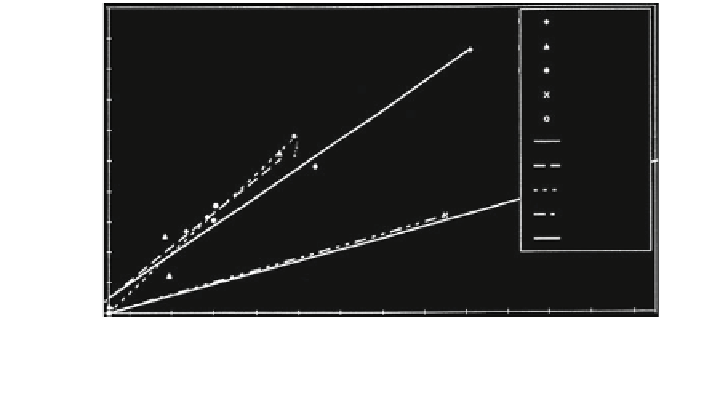Civil Engineering Reference
In-Depth Information
50
2
R
=0.9819
MHMJ Series
MKZJ Series
MFYA Series
2
R
=0.8841
40
2
R
=0.9949
MFYA 14
MFYA 40
30
Linear (MHMJ Series)
Linear (MKZJ Series)
Linear (MFYA Series)
Linear (MFYA 14)
Linear (MFYA 40)
20
10
0
1
3
5
7
9
11
13
15
17
19
21
23
25
loss of stiffness in %
Fig. 2.48
Relation between loss of strength and loss of stiffness, Paton et al. (
2001
)
relation between rope endurance and the number of (inner) wire breaks is still
unknown, the wire rope should be designed for the number of load cycles where at
most 1 % of the rope wires on a rope length 30 d are broken.
Paton et al. (
2001
) tested the residual rope breaking force after having different
numbers of load cycles. They found a relation between the loss of rope breaking
force and the loss of length stiffness S/DL. In Fig.
2.48
this relation is shown for
6-strand Warrington-Seale ropes with steel cores of 40 and 70 mm diameters.
They recommend using a discarding criterion of a loss of 10 % of the wire rope
breaking force measured.
2.6.5 Calculation of the Number of Load Cycles
2.6.5.1 Resin Sockets
With the test results and the related equations, the number of load cycles prior to
rope breakage can be calculated for open spiral ropes of nominal strength 1, 370-1,
770 N/mm
2
, zinc coated and for Warrington-Seale ropes 6 9 36 to 6 9 49-
IWRC-sZ of the nominal strength 1, 570-1, 960 N/mm
2
, bright or zinc coated,
lubricated. For these, the regression (
2.102
) respectively (
2.102a
), (
2.103
) for the
varying quantile c and (
2.107
) for the influence of the rope length will be com-
bined. To give a better overview, the unit factors S
e
= 1 N and d
e
= 1 mm (to
make the ratios dimensionless) will be removed. Then, for a rope with the length L,
the number of load cycles—where with a certainty of 95 % at most a quantile c of
the wire ropes has been broken—is

Search WWH ::

Custom Search